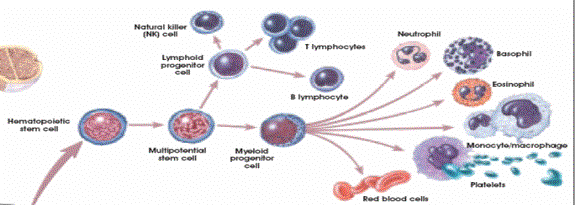The Effects Of Simulated Microgravity On Human Umbilical Cord Blood Hematopoietic Stem Cells

Figure 1: Hematopoietic stem cell differentiation.
The Effects Of Simulated Microgravity On Human Umbilical Cord Blood Hematopoietic Stem Cells |
| A stem cell is a cell that has the ability to divide (self renew) and, under the right conditions, give rise (differentiate) to the many different cell types that make up an organism, including heart cells, skin cells, blood cells, and nerve cells. Hematopoietic stem cells (HSC) are blood-forming stem cells which can differentiate into white blood cells (lymphocytes, granulocytes, and monocytes), red blood cells, and platelets (Figure 1). HSC transplants are now routinely used in treatments for certain cancers, such as leukemia, and immune and genetic disorders, where the massive recovery of healthy white blood cells is needed. However, HSC have been unable to readily proliferate (self renew) in vitro. This problem is presently hindering the progress of cell replacement research. |
|
Figure 1: Hematopoietic stem cell differentiation. |
| Less conventional methods of culture have been studied in order to overcome this setback, including that of simulated microgravity, in which a fluid filled rotating culture chamber maintains cells in a continuous state of free fall. This method of culturing cells was originally developed by NASA in order to examine the effects of zero gravity on space travelers in vitro. One study has shown that hematopoietic bone marrow cell proliferation and differentiation (production of progenitor, or precursor cells) decrease in simulated microgravity due to changes in the rheological properties of the cell. When assayed for primitive hematopoietic potential in secondary conventional static long-term cultures, cells cultured initially in microgravity produced greater numbers of cells and progenitor cells, and for a longer period of time, than cultures initiated in a static environment, proving that microgravity is beneficial for culturing bone marrow HSC by reducing the rate of proliferation, favoring self renewal or maintenance of the primitive phenotype (Plett et al, In Vitro Cellular and Developmental Biology – Animal, 37, No 2, 73-78). The current idea is to culture HSC from other blood stem cell products, including human cord blood and peripheral blood stem cells. Cord blood is very rich in primitive stem cells making it an interesting candidate for culture in simulated microgravity. HSC derived from human cord blood will be cultured in simulated microgravity, and proliferation rates, differentiation rates, and the production of progenitor cell colonies will be measured. Presently, no work has been done on culturing human cord blood HSC in microgravity. |